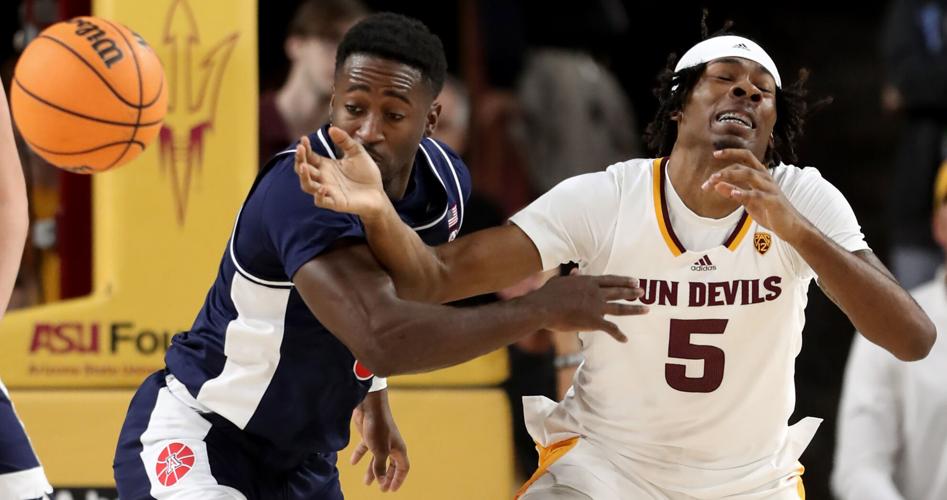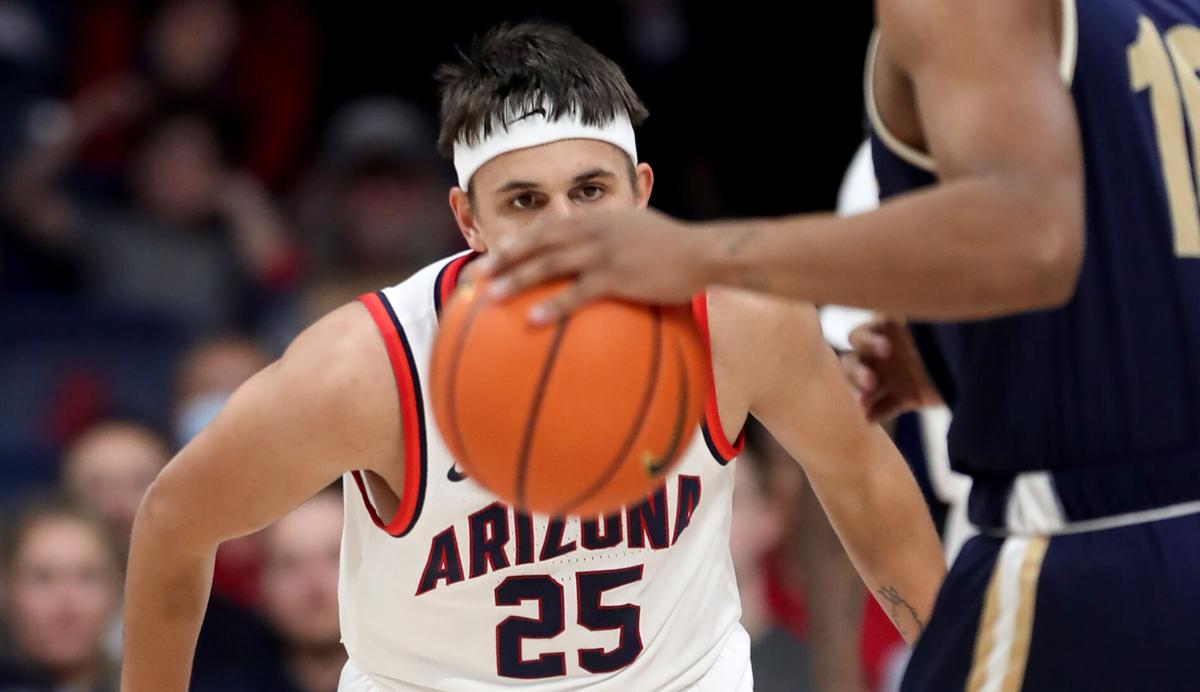Only twice this season has the most efficient offense in Division I been held under 42% shooting from the field.
The first time didn’t work out so well for Arizona. On Nov. 30 in Salt Lake City, the Wildcats — who lead the nation with 119.7 points scored per 100 possessions — shot just 35.2% and scored just 66 points in a 15-point loss to Utah.
But on Saturday in Tempe, Arizona shot just 37.7% from the field, made just 5 of 22 3-point shots (22.7%), scored only 69 points and … still beat the Sun Devils by nine.
The Wildcats did it by keeping ASU to even worse field-goal percentages, 36.6% overall and just 3 for 37 (11.1%) from 3.
“We’re gonna be a great defensive team,” UA coach Tommy Lloyd said at ASU, when asked about pulling out a game like Saturday’s. “We’re gonna be a great defense and rebounding team. I don’t care what our offense is ranked. I just care about getting the result.”
While still adjusting to life without shot-swatting center Christian Koloko, the Wildcats have a defense that is still notably behind its offense in efficiency rankings. While Koloko led the Pac-12 in blocked shots and changed countless others, the Wildcats’ perimeter defenders were freer to extend defensively and take chances.
Not as much now.

Arizona guard Courtney Ramey and Arizona State forward Jamiya Neal bounce off one another in the Sun Devils’ key during the first half of Saturday’s game.
“Traditionally, I’ve been a guy that would be way more comfortable taking away 3s, and then relying on length and athleticism for rim protection and size in the paint,” Lloyd said last month. “Those are the little things we got to figure out and that’s my job to put this team on the right path.”
Against ASU, the Wildcats straddled that line successfully. They limited ASU center Warren Washington to just four shots, kept power forward Devan Cambridge to 2-of-8 shooting while also benefitting by letting big forwards Alonzo Gaffney (1 of 5) and Cambridge (0 for 4) shoot 3s.
Here’s how the Wildcats rank in the major defensive metrics, according to KenPom.com:
59: Rank in defensive efficiency. The Wildcats score 119.7 points per 100 possessions, more than anyone else in Division I, but are allowing opponents to score 95.3 points per 100 possessions.
Especially because the Wildcats run an extraordinarily fast tempo, that pace-independent measure is much more telling of their defense than the raw “scoring defense” number of 72.3 points – which is actually last in the Pac-12.
63: Rank in 2-point percentage defense (45.9). This stat is probably the single biggest measure of the difference between last season’s Koloko-engineered defense and this one. While center Oumar Ballo and forward Azuolas Tubelis have formed one of the country’s best post duos, the Wildcats’ interior defense is still down notably from the No. 2 ranking it held in this stat (41.8) last season. The fact that UA is without the length and athleticism of their two other NBA draft picks off last season’s team, Dalen Terry and Bennedict Mathurin, is also likely a factor.
108: Rank in 3-point percentage defense (31.8). UA assistant coach Riccardo Fois says this stat is mostly “for fans,” a sometimes deceiving metric because it can depend upon a team’s defensive philosophy — and its opponents’ flat-out ability to shoot the long ball.
On Saturday in Tempe, even ASU guard Frankie Collins admitted the Sun Devils may have ultimately contributed to UA’s 3-point defense.
“They made us take some tough 3s but I feel like we got a lot of good shots,” Collins said. “We just didn’t make them.”
For what it’s worth, Arizona’s 3-point defense (32.8) was comparably mediocre last season when the Wildcats overall ranked 21 in defensive efficiency (92.6).
64: Rank in effective field-goal percentage defense (46.6). This stat measures field-goal percentage defense but gives 50% more credit for 3-point shots. It is up notably from UA’s defensive 3-point percentage in part because opponents are taking only 38.3% of their shots from 3-point range, a below-average ratio in Division I.
143: Rank in block percentage (9.6). With Koloko last season, the Wildcats ranked 25th by blocking opponents’ shots 13.4% of the time.
278: Rank in steal percentage (7.9). This number is also subject to a team’s defensive philosophy, and the Wildcats aren’t known for excessively gambling for steals. But they still managed to steal the ball on 9.2% of opponents’ possessions last season.
That could have been partly because of Koloko’s influence on perimeter defense and the ranginess of Terry (who stole the ball on 2.5% of opponents’ possession last season). But Tubelis had a steal percentage of 2.4 last season and is up to 3.0% this season.
318: Rank in turnover percentage (16.1). Overall, Arizona’s opponents are turning the ball over fewer times than last season, when they averaged a turnover on 17.4% of possessions (the No. 231 ranking).
40: Rank in defensive rebounding percentage (75.4). Thanks largely to the Pac-12’s top two rebounders, the Wildcats have improved notably in this one defensive stat. Ballo averages 9.3 rebounds a game and ranks 64th nationally in defensive rebounding percentage, grabbing 24.8% of opponents’ missed shots when he’s on the floor. Tubelis averages 8.7 rebounds overall and ranks 188 in defensive rebounding percentage at 21.0.
Extra points
Despite getting some potential help from former coach Sean Miller, Arizona remained at No. 5 in the Associated Press Top 25 poll on Monday. The Wildcats (13-1) beat ASU 69-60 on Saturday, while Miller’s Xavier team handed UConn its first loss of the season that day. However, UConn (14-1) dropped only from No. 2 to No. 4, still staying ahead of the Wildcats. Xavier (12-3) moved from No. 22 to No. 18, having found quick success under Miller, who was fired by Arizona in April 2021 and rehired at Xavier a year later. Miller also coached five seasons at Xavier before becoming UA’s coach in 2009-10. Among other Arizona opponents this season, UCLA moved up a spot from No. 11 to 10 while Tennessee dropped from No. 7 to No. 8 and Indiana rose from 16 to 15.
Colorado guard KJ Simpson was named the Pac-12’s Player of the Week after averaging 28 points, 5.0 rebounds and 4.5 assists in the Buffaloes’ games at Stanford and California. A former UA signee, Simpson had a career high 31 points in CU’s 73-70 win at Stanford, including 11 in the final five minutes. UA had nominated Azuolas Tubelis, who had 21 points and nine rebounds at ASU.
UCLA center Adem Bona was named Pac-12 Freshman of the Week after averaging 12.5 points and 4.5 rebounds in the Bruins’ sweep at Washington State and Washington.
No. 5 Arizona moved to 12-1 after handling Morgan State 93-68 on Thursday at McKale Center.






